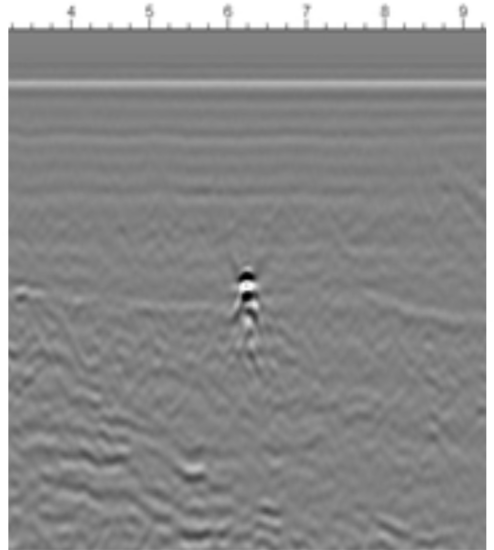How can I do a velocity calibration for my GPR investigation?
Velocity calibration of GPR data can be carried out in several different ways; to use the depth to a known object, by a hyperbola fitting tool, by migration or by using standard velocities (from tables). You can also carry out velocity soundings, such as, CMP (Common Midpoint) or WARR (Wide Angle reflection and refraction).
In this help article we will discuss how to make accurate velocity calibrations using the depth to a known object, by using a hyperbola fitting tool and by using migration. It should be noted that, as a rule of thumb, most depth estimations of GPR investigations are approximately accurate to about 10% of the actual depth of an object (hyperbola fitting and migration). More accurate depth estimations can be achieved by measuring the depth to a known object, but this is only more accurate if the soil between the surface and the known object is homogenous.
Calibration to a known object
If the true depth of an object visible in the radargram is known, this depth can be used to estimate the velocity of the electromagnetic waves travelling between the GPR antenna and the object. If the GPR antenna is positioned over this known object, you can set the depth to the object, and the GPR system will automatically calculate the velocity (v) by v = d/t, where d (distance in m) and t (time in ns, the two-way travel time is known. This velocity will then be applied to the whole radargram.
 Known depth to a marked object can be set
Known depth to a marked object can be set
Hyperbola fitting
If there is a clear hyperbolic response in the radargram, you can use the shape of the hyperbola to calculate the velocity of the media you are investigating. The angle of the hyperbola arms (i.e. how steeply the arms dip) is directly related to the velocity of the GPR signal. A wider angle means a higher velocity and vice versa. The hyperbola fitting tool activates a simulated hyperbola which is superimposed on top of your measured data. Simply adjust the shape of this computer-generated hyperbola to fit your measured hyperbolic response to obtain the velocity.
 Velocity is too low
Velocity is too low
 Correct velocity
Correct velocity
 Velocity is too high
Velocity is too high
Migration
The collected data can also be migrated to get an estimated velocity. Migration will have the effect of removing the arms of the hyperbola and instead leave a single point in the radargram. When you have found the correct velocity of a migrated hyperbola you can apply this velocity to your entire radargram or project (as an average).
 Velocity is too low
Velocity is too low
 Correct velocity
Correct velocity
 Velocity is too high
Velocity is too high
More to read
Application areas
https://www.guidelinegeo.com/application-areas/
Methods
https://www.guidelinegeo.com/ground-penetrating-radar-gpr/
Case Stories
https://www.guidelinegeo.com/solutions/case-stories/
Products
https://www.guidelinegeo.com/mala-ground-penetrating-radar-gpr/
